Canada is a country bursting with wildlife, from its bustling cities to its untouched wilderness. While you might be familiar with some of the more common Canadian animals like moose and beavers, Canada is also home to some incredibly rare and unique animals. You may have heard of some of these, while others are lesser-known.
Unfortunately, some of these rare animals in Canada are on the brink of extinction or endangered. This makes sightings all the more incredibly rare and special. In this article, we’ll highlight 10 of the rarest animals in Canada. So, let’s dive in and get to know these animals and raise some awareness of the 10 rarest animals in the country.
#10: Blanding’s Turtle (Emydoidea blandingii)
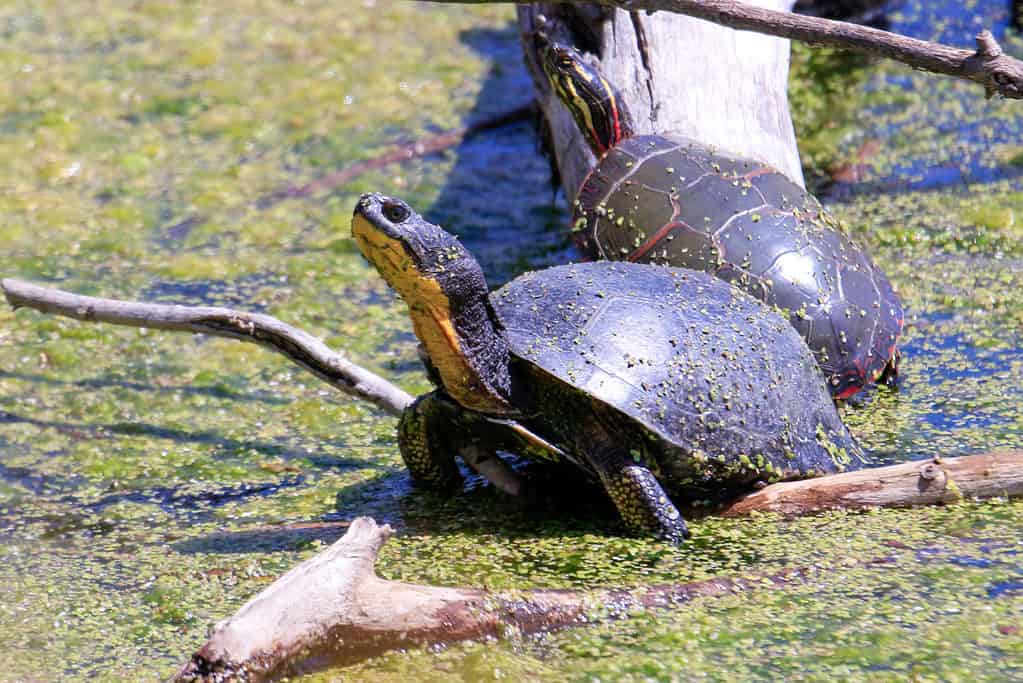
A medium-sized turtle, the Blanding’s turtle usually lives in areas with gentle and shallow water.
©iStock.com/mynewturtle
The Blanding’s turtle is a medium-sized turtle (adult carapace length of 5 to 11 inches) you might find in freshwater settings. Its upper shell curves gracefully and is usually dark brown or black in color. The shell is speckled with light yellow or tan markings.
You’re most likely to spot these turtles in calm, plant-rich waters, like sluggish rivers, marshy areas, and shallow lakes or ponds. These turtles eat anything from fish and frogs to insects and even dead animals.
You’ll usually see Blanding’s turtles in areas with gentle, shallow water flows. But, unfortunately, they’re an endangered species in Canada. The two major threats they face are traffic-related deaths and the continued destruction of their wetland homes. Unnaturally large populations of their predators have also led to nest predation.
Although exact data is scarce, available information indicates that their numbers have dropped by more than 60% in the last 120 years. If current trends hold, road-related deaths alone could halve their adult population in the coming years.
#9: Beluga Whale (Delphinapterus leucas)
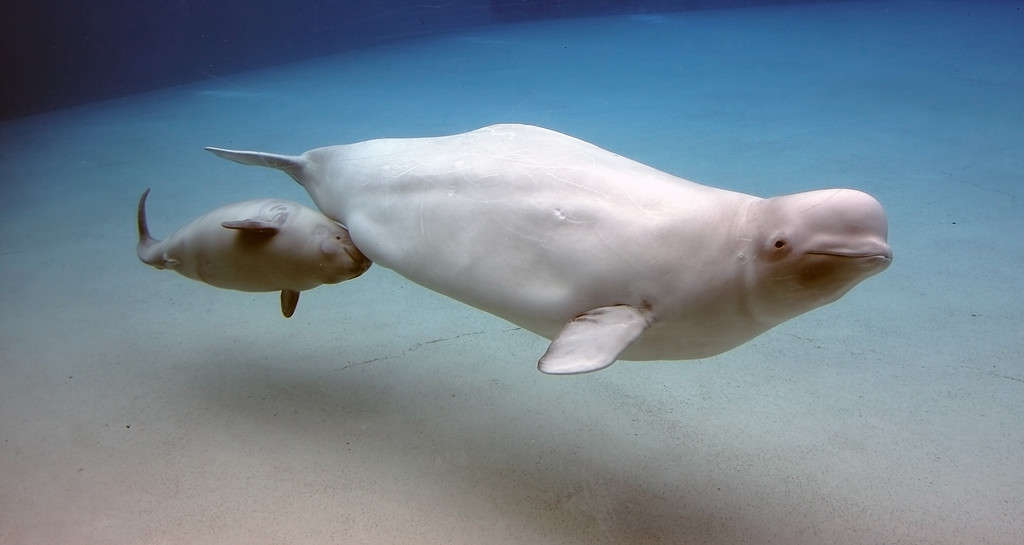
Growing up to 15 feet long, beluga whales turn white in color as they get older.
©Christopher Meder/iStock via Getty Images
Beluga whales start life with gray skin but transition to white as they get older. They have stocky bodies and a pronounced, rounded forehead. Furthermore, instead of the typical dorsal fin, they feature a ridge along their backs. These whales also have particularly flexible necks. This allows them to move their heads in all directions, up and down and side to side.
When born, beluga whales measure around 5 feet but can grow to lengths between 11 and 15 feet as adults. As a general rule, females are smaller than males.
These whales call the Arctic Ocean and its surrounding waters home. They’re frequently found in Alaska, Russia, and, of course, in Canada. Their diverse menu includes various sea creatures like octopus, crabs, shrimp, and even snails and sandworms.
Belugas face many challenges, ranging from pollution and habitat loss to conflicts with fishing activities and oil exploration. They’re also at risk from diseases, killer whale attacks, and other human-related disruptions.
In Canada, the health of beluga populations varies by location. According to the Committee on the Status of Endangered Wildlife in Canada, beluga whales in Ungava Bay and Cumberland Sound are in an endangered state. Those in Eastern Hudson Bay are threatened, while the populations in the eastern High Arctic/Baffin Bay are of particular concern.
#8: Peary Caribou (Rangifer tarandus pearyi)
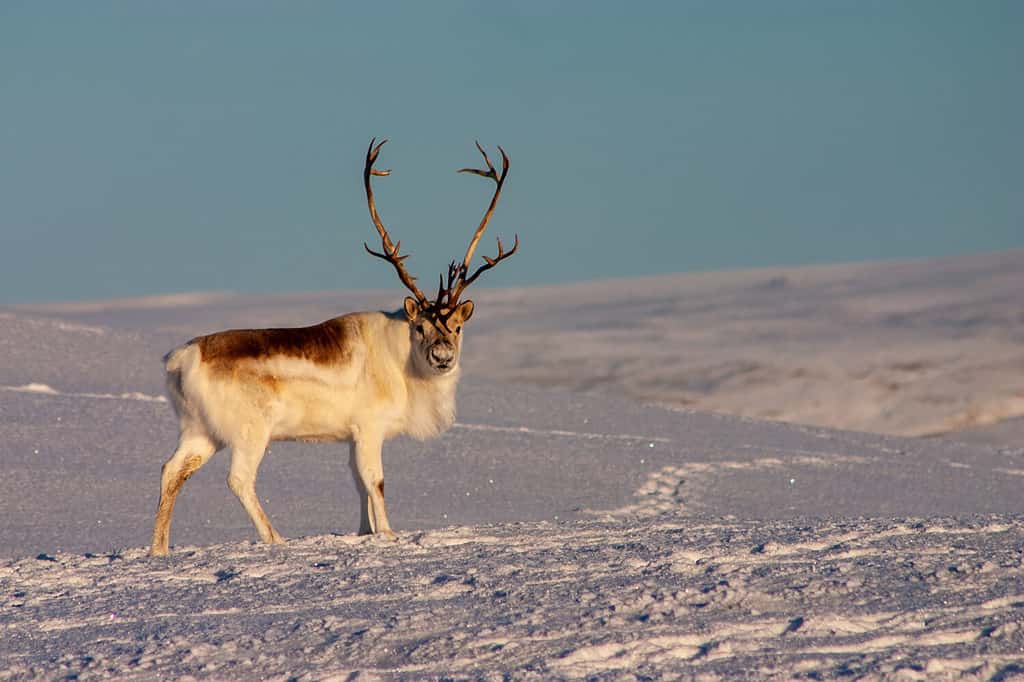
One of the rarest animals in Canada is the Peary caribou, which lives in the Arctic tundra.
©Paul Loewen/Shutterstock.com
Peary caribou mostly have white fur but feature a grayish back and a stripe of the same color down their front legs. During winter, some Peary caribou look almost entirely white. Unlike deer and other caribou, their antler velvet is gray. Female Peary caribou usually measure about 4 feet 7 inches. Males are a bit larger at 5 feet 7 inches.
These majestic creatures inhabit the barren Arctic tundra, primarily in areas that are essentially polar deserts, featuring short, chilly summers and extended, frigid winters. When the Arctic plants briefly flourish, these caribou munch on a variety of plants, including willows, mosses, and grasses.
Climate change poses a significant threat to this endangered species in Canada. Also, shifts in the timing of Arctic ice melting and freezing disrupt their migratory habits and make food harder to find.
Due to their far-flung habitats across Arctic islands — which are linked by sea ice during winter — it’s hard to keep an exact count of their numbers. However, experts estimate that around 13,200 mature individuals are still out there.
#7: Leatherback Sea Turtle (Dermochelys coriacea)

Found in coastal areas in the summer in Canada, the leatherback
sea turtle
population is dwindling.
©Stephanie Rousseau/Shutterstock.com
Leatherback sea turtles have a unique color pattern, featuring a black base speckled with hints of blue, pink, and white. What sets them apart from other sea turtles is their unique shell, which isn’t hard but rather a flexible covering made of a fatty layer with small bones beneath a layer of skin. They are the biggest among the existing types of sea turtles. Some individuals grow longer than 6.5 feet and weigh over 1,000 pounds!
These leatherback sea turtles are found in ocean waters across the Atlantic, Pacific, and Indian Oceans. Their preferred food comes from the open sea and includes soft-bodied creatures like jellyfish and tunicates. But these sea turtles will also eat fish, algae, and seafood.
In Canada, these turtles frequent coastal areas during summertime to feast on jellyfish. They’ve been labeled as endangered in the country since 2003. Their numbers have dwindled globally by over 70% due to various threats like unintentional capture in fishing gear, coastal development, ocean pollution, and egg poaching, among other factors.
Because these turtles travel vast distances across the ocean, saving this species isn’t just a Canadian issue but one that calls for vast international efforts.
#6: Atlantic Salmon (Salmo salar)
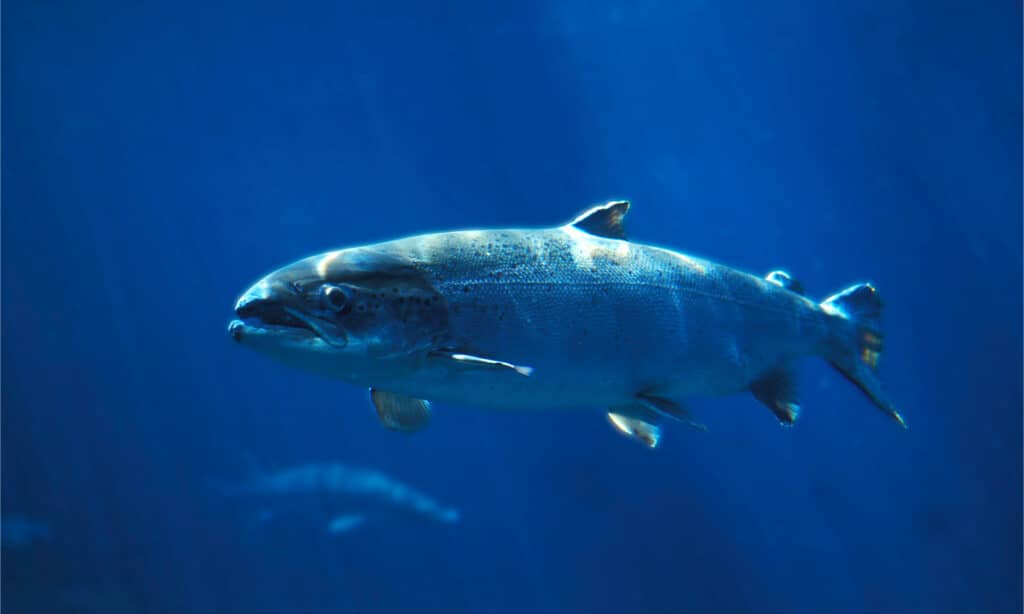
Dams, habitat destruction, and overfishing all lead to the dwindling numbers of Atlantic salmon.
©slowmotiongli/Shutterstock.com
Atlantic salmon have slender bodies and small heads with flat snouts. The mouth of these fish reaches back past their eyes. Adults boast a silver hue with almost completely white bellies, and they’re speckled with unique blue-green X-shaped spots all over their bodies and heads. These fish are the biggest in their family and typically measure between 28 and 30 inches after spending two years in the ocean.
Starting off in rivers where they’re born, Atlantic salmon move out to the ocean for nourishment and growth and then return to their home rivers to lay eggs. Their diet varies, including fish like capelin and herring, crustaceans like krill, and even cephalopods.
Structures like dams are problematic for these fish as they obstruct their essential migratory paths. Their numbers are also dwindling due to habitat destruction and overfishing.
The population of Atlantic salmon has significantly decreased since 1995, now hovering between 400,000 and 700,000. For instance, the number of adult salmon in the Miramichi River plummeted from 112,000 in 1992 to just 15,300 in 2019, which puts them on the endangered and rare species list across the nation.
#5: Wolverine (Gulo gulo)
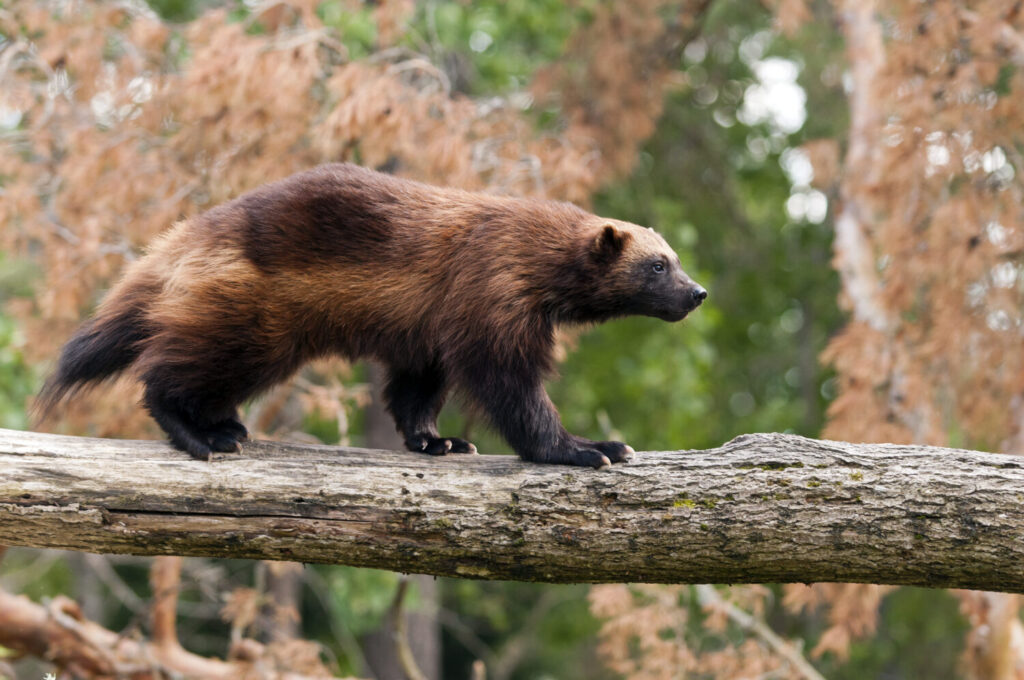
One of the rarest animals you’ll see in Canada is the wolverine.
©Nazzu/Shutterstock.com
The wolverine has stocky legs that curve slightly, along with furry soles and sharp claws that can partially retract. Their ears are small, and they have robust teeth. Males are generally bigger than females, typically measuring between 33 and 44 inches long, including the tail. Wolverines generally weigh 25 to 40 pounds.
These animals are primarily found in isolated northern forests and open tundra regions, and they mainly eat small mammals like rabbits and various rodents.
Since Europeans began settling in Canada, wolverines have lost much of their original habitat due to land development and urban expansion. Illegal hunting has also contributed to their decreasing numbers, as their fur is highly valued for resisting frost. Additionally, overhunting of caribou, a main food source for wolverines, has also had an impact.
Nowadays, these elusive animals are mostly seen in the far-northern areas stretching from British Columbia to Ontario. While the population size is difficult to estimate according to the latest statistics, the wolverine population is estimated to range between 15,000 and 19,000 individuals.
#4: Burrowing Owl (Athene cunicularia)

Unfortunately, due to habitat loss and pesticides, there are only around 1,000 pairs of burrowing owls in Canada.
©SunflowerMomma/Shutterstock.com
Burrowing owls have big, yellow eyes, long, skinny legs, and short, boxy tails. Interestingly, they don’t have the ear tufts commonly found in other owls, and their light brown feathers are speckled and striped with white. These owls are around 10 inches tall, making them one of the smallest owl species. Furthermore, burrowing owls weigh just 6 ounces.
They call the arid landscapes of western North America home and some of the drier parts of Central and South America. Their meals consist of various critters, including small birds, fish, reptiles, and insects.
Their dwindling numbers are largely due to the loss and breaking up of their natural habitats. Pesticides used in farming can also indirectly harm them when they consume contaminated prey.
To save this endangered bird, federal plans in Canada recommend multiple conservation actions. These include preserving the natural environment, avoiding the killing of animals the owls feed on, and setting up safe artificial nests. Breeding and releasing them back into areas where they’ve disappeared is also seen as crucial.
Experts believe that less than 1,000 pairs of these owls are in Canada, making them some of the most at-risk and rarest birds in the country’s grasslands.
#3: Whooping Crane (Grus americana)
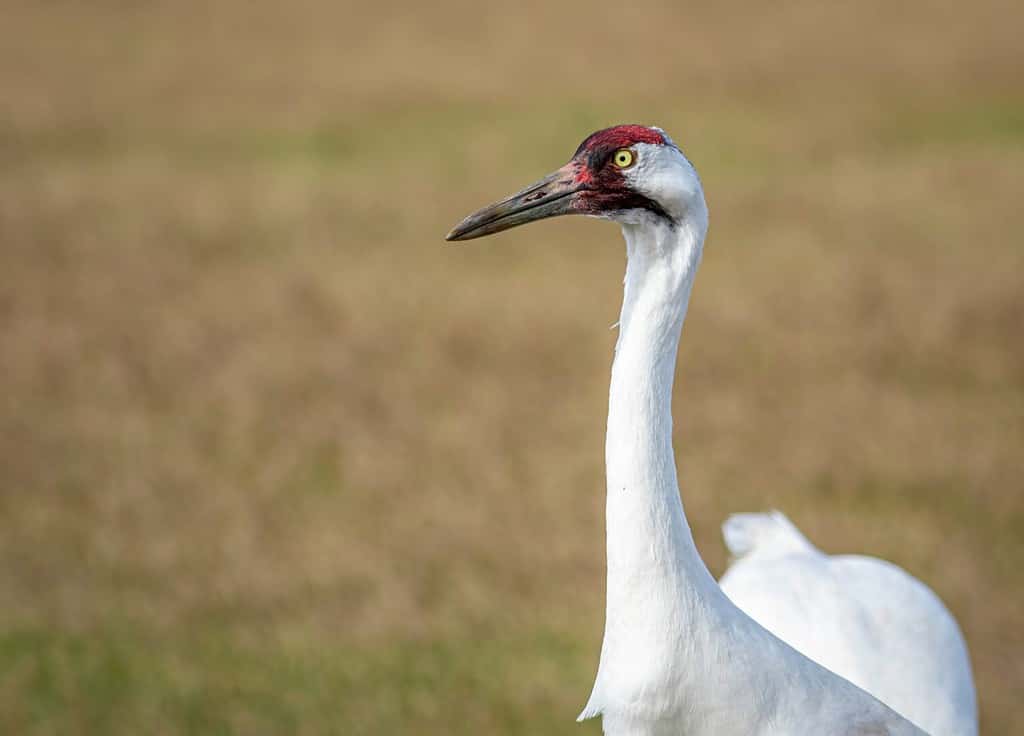
The only place to see this rare animal in Canada is at the Wood
Buffalo
National Park.
©Matthew Jolley/Shutterstock.com
The whopping crane is mostly covered in bright white feathers, except for a touch of red and some black feather tips on its wings. It has yellow eyes and slender black legs. As North America’s tallest bird, it stands nearly five feet tall and has a wingspan of 7.5 feet. Their diet is quite diverse, including small water creatures, tiny land animals, and plant matter like roots, acorns, and berries.
In Canada, you can only find these birds nesting in Wood Buffalo National Park, where they are legally protected. Public entry into their nesting areas is restricted from September to April, with exceptions made only for park officials and researchers.
The Nature Conservancy categorizes them as extremely rare and at high risk of disappearing. They are also listed as endangered by Manitoba’s and Saskatchewan’s environmental agencies.
Thanks to rigorous conservation efforts, their numbers have increased from just 18 in 1938 to 505 in 2018. As of 2020, the estimated count of these birds in the wild was around 677, with an additional 177 in captivity across 17 facilities in Canada.
#2: Vancouver Island Marmot (Marmota vancouverensis)
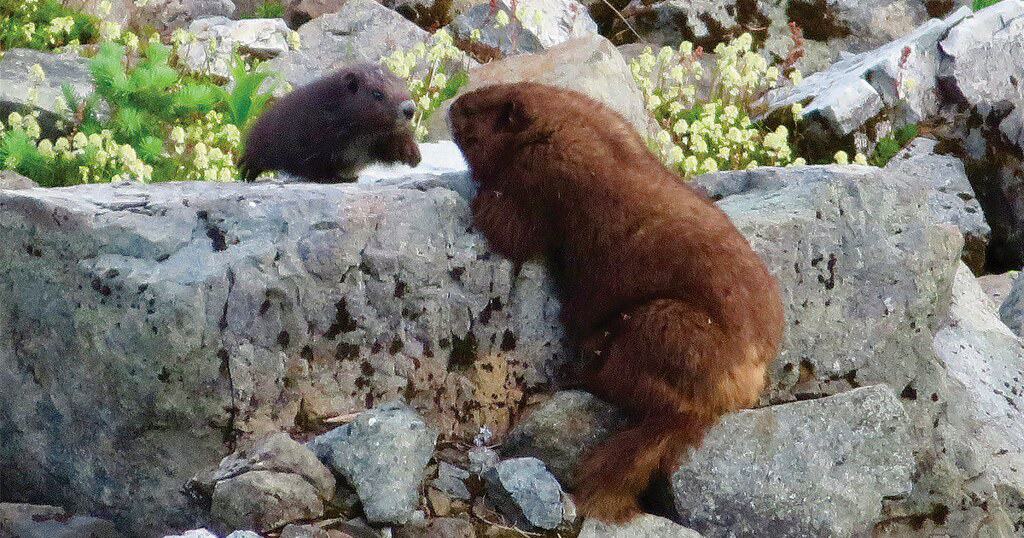
Only found on Vancouver Island, the Vancouver Island marmot is critically endangered in Canada, making it one of the rarest animals in the country.
©Province of British Columbia/Flickr – License
The Vancouver Island marmot is a distinct marmot species, recognized by its dark brown fur and unique white patches on its nose, belly, and head. The fur of younger marmots is even darker, nearly black in color. These marmots can grow up to 28 inches long.
As its name suggests, this marmot only lives on Vancouver Island. They also inhabit sub-alpine meadows. In terms of diet, they’re strictly plant-eaters, feeding on a wide variety of more than 40 types of grasses, herbs, and wildflowers.
The species faces immediate dangers primarily from natural predators and the impact of logging activities on their habitat. Climate change could also lead to long-term challenges, as it could alter their living spaces.
The Vancouver Island marmot is critically endangered in Canada. In 2007, there were as few as 30 individuals. Thankfully, conservation efforts have increased their numbers to between 250 and 300 as of 2021.
#1: Black-Footed Ferret (Mustela nigripes)
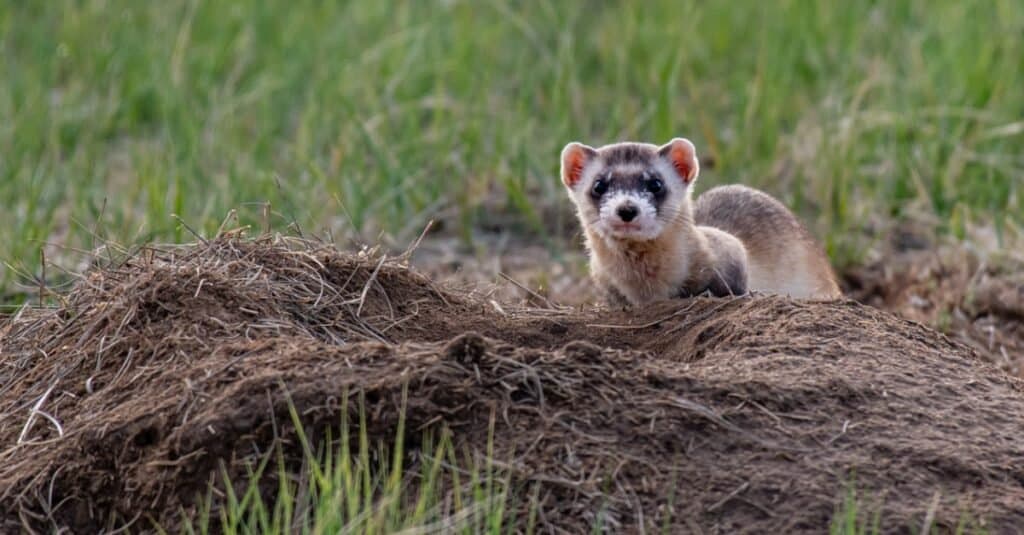
Technically considered extirpated in Canada, the black-footed ferret is the rarest animal in Canada.
©iStock.com/Kerry Hargrove
The black-footed ferret is a slim, elongated animal with stubby legs. It typically measures between 15 and 25 inches from its head to the end of its body. Recognizable by its dark feet, facial markings, and the tip of its tail, this animal is on the verge of extinction in Canada.
These ferrets prefer to live in areas with short grass. Their diet mainly consists of prairie dogs, about 90% of what they eat. Black-footed ferrets also eat other rodents, such as squirrels and mice.
Due to a decline in the prairie dog population, their main food source, these ferrets were wiped out in Canada. In fact, the last sighting of a wild ferret in Canada was way back in 1937, and by 1978, they were declared extirpated. In other words, they were declared to have disappeared completely from the country. However, there have been efforts to reintroduce the species into Grasslands National Park in Saskatchewan.
Unfortunately, even with regular checks, this hard-to-spot animal hasn’t been seen in Canada’s natural areas for some time. While a few are kept in controlled environments, they’ve essentially vanished from Canada’s wild spaces, making them one of Canada’s rarest animals.
Summary of the Rarest Animals in Canada
| Rank | Animal | Scientific Name | Conservation Status (Canada) |
|---|---|---|---|
| 1 | Black-Footed Ferret | Mustela nigripes | Extirpated |
| 2 | Vancouver Island Marmot | Marmota vancouverensis | Endangered |
| 3 | Whooping Crane | Grus americana | Endangered |
| 4 | Burrowing Owl | Athene cunicularia | Endangered |
| 5 | Wolverine | Gulo gulo | Endangered |
| 6 | Atlantic Salmon | Salmo salar | Endangered |
| 7 | Leatherback Sea Turtle | Dermochelys coriacea | Endangered |
| 8 | Peary Caribou | Rangifer tarandus pearyi | Endangered |
| 9 | Beluga Whale | Delphinapterus leucas | Endangered |
| 10 | Blanding’s Turtle | Emydoidea blandingii | Endangered |
The photo featured at the top of this post is © Christopher Meder/iStock via Getty Images
Thank you for reading! Have some feedback for us? Contact the AZ Animals editorial team.






